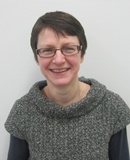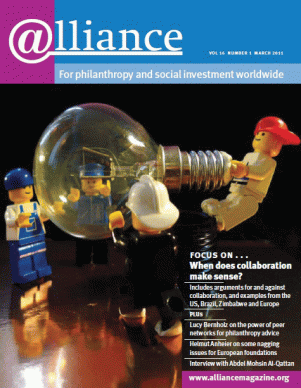The Youth Empowerment Partnership Programme (YEPP) has made important contributions to the field of youth and community empowerment – and we believe resulted in sustainable change. Part of YEPP’s success – and its legacy – is that a specific approach to youth and community empowerment was developed and closely monitored in 18 local sites in eight European countries. Extensive evaluations and assessments document where the model worked and where and why it did not. Where it was successful, a wide range of stakeholders working collaboratively at international, national and local levels were able to achieve positive change for the benefit of vulnerable youth in their communities. YEPP is also a unique foundation collaboration.
Conceived in the EFC Youth and Education Interest Group in 1999, YEPP was established as a programme in 2001 by a group of foundations interested in moving beyond being an interest group and working collaboratively. Now in its tenth year, YEPP’s current steering committee includes six foundations as well as the Network of European Foundations (NEF) and the International Academy at the Free University of Berlin (INA), the programme’s designer and implementer since the beginning.
Given that for nearly ten years this foundation partnership has been at the heart of YEPP, it is worth stepping back and weighing the benefits and challenges of such close collaboration.
A core principle of YEPP’s approach to youth empowerment is partnership: by bringing together diverse stakeholders at local, national and international levels, circumstances affecting marginalized young people can be addressed in more effective and sustainable ways. The foundation partnership behind YEPP reflects this principle. YEPP gathered European and US foundations, large and small, each of which shared an interest in improving conditions for young people. As the project evolved, this focus on partnership led to a variety of other very creative collaborations, particularly at local and national levels where YEPP was active.
This mix of foundations also brought a diversity of experience, approaches and local knowledge – from inner-city Dublin to remote Finnish islands to central Bosnia. Additionally, the learning from the programme was cycled back into these foundations and the broader field. The structure acknowledged the role of foundations and targeted the improvement of their practice as well as that of practitioners, policymakers and other agencies.
But we all soon learned that going beyond what we were doing individually and collaborating with other foundations to do something new was not as easy as it sounded.
New initiative, new money
Issues related to funding for YEPP challenged the partnership. The foundations involved in YEPP set out to do something new, not simply to share experiences with existing projects. This required some level of programme infrastructure – in this case, a programme team based at INA in Berlin. It also meant activities – extensive networking events, training, evaluation, and monitoring. These transnational events and activities involved a wide range of stakeholders, including hundreds of young people. The costs of the new infrastructure and activities were covered by the YEPP budget, to which all participating foundations were expected to contribute.
Most of the foundations were already working locally on youth projects. When they joined YEPP, they were expected to invest more in these sites to have them operate as YEPP sites and to launch new sites reflecting YEPP’s youth and community empowerment principles. The local investment by many of the foundations during the project has been substantial.
As YEPP grew, new money was needed to fund the central budget and at the same time participating foundations were encouraged to expand the number of YEPP programme sites they funded directly. For many, this was a serious issue. We debated the relative importance of the central and local levels as well as what was a ‘fair’ contribution from each foundation. Recognizing and accommodating the variety of ways foundations contributed to YEPP was important to maintaining a sense of equality among the different partners. Ownership of the programme – and decisionmaking – was never based on a foundation’s financial contribution to the YEPP budget.
On this issue, the mix of foundations within the project has also been a positive. The larger foundations, Mott included, have been able to provide the majority of core funding while smaller foundations – or foundations without a clear transnational mandate – have directed funding to local projects and sites.
Institutional and personal commitment
YEPP is not business as usual for any of the participating foundations. While we all like to believe we are innovative, responsive and flexible, the truth is that this is difficult in practice. In addition to finding new money to invest over the long term (now nearly ten years), the foundations and their representatives had to commit significant time and energy. We have two to three steering committee meetings annually, each involving two to three days when travel is included. The quality of these meetings improves when they take place in local YEPP sites, but this typically involves more travel and expense, given the location of some sites. Events and activities require the involvement of the participating foundations – and of course many foundations are directly involved in the local sites in their countries.
As the programme evolved, there were new opportunities to expand the partnership, increase the number of sites, share results and lessons, and engage in policy advocacy. While the programme team was responsible for most of this, the need for involvement by the foundations increased as well. Many found it difficult to take on new responsibilities and commit more time. This has strained both individual capacities and institutional commitment at times. It has required a great deal of discussion and, in the end, compromises. There have also been a lot of people going the extra mile – this was essential at times to making things work and getting over some bumps along the way.
Trust and shared goals
A 2007 assessment by the Organization for Economic Cooperation and Development (OECD – one of the initial partners in YEPP) of the foundation partnership at the core of YEPP noted that a lesson learned is that it would have been helpful to develop a formal agreement ‘at the onset of cooperation with all partners’. There has never been a formal agreement among the participating foundations in YEPP – though there are agreements between partners at other levels (in local YEPP sites, for example). This contributed to the difficulty of working through practical issues (how do certain activities get funded, for example) and higher level issues such as, why are we doing this at all?
While a formal agreement would perhaps have helped, there can be no substitute for a relationship of trust among the foundations and other partners. Over ten years, there were many issues that had to be resolved – including differences about fundamental strategic directions. There was always something to sort out and negotiate, particularly as the project and the partners’ interests evolved. Trust had to be built and rebuilt along the way. Despite the time and resources required, we learned that email and conference calls – even with video – could not replace face-to-face meetings.
YEPP has been a substantial investment of time and resources for all involved, but none of the participating foundations working alone would have got YEPP to where it is today. The close foundation collaboration behind YEPP sustained the programme and was the basis on which it expanded and fostered a range of other, dynamic, innovative partnerships among different stakeholders at local and national levels.
Today, YEPP has most likely outgrown the foundation-led model that created it. For the foundations involved, perhaps the most important test of the collaboration will be how the project’s various stakeholders at the local and national levels (including young people, practitioners and youth workers, evaluators and funders) work together to design and support the next stage of development.
Walter Veirs is regional director, CEE/Russia at the Mott Foundation. Email WVeirs@mott.org
Mott has been a participating foundation in YEPP since the beginning of the project. Walter Veirs currently serves as the vice-chair of the YEPP steering committee. This article represents one donor’s perspective. Some comments from other donors are included.
About YEPP
The Youth Empowerment and Partnership Programme (YEPP) was launched in 2001 by a group of European and US foundations, the OECD and the International Academy at the Free University of Berlin working under the auspices of the Network of European Foundations (NEF). It acts as a platform for youth and community empowerment in disadvantaged areas throughout Europe. Starting with 7 local sites in 2001, YEPP is now active in 18 sites in Belgium, Bosnia and Herzegovina, Finland, Germany, Ireland, Italy, Poland and Slovakia.
YEPP’s mission and goals
YEPP’s mission is to empower disadvantaged young people to become agents of change in their communities by setting up multi-level networks and partnerships to fight social exclusion and promote youth participation in decision-making. It brings together young people and a range of local actors to address the most important issues they face in their communities. Their achievements are closely monitored with the support of evaluation specialists. At the transnational level, a central programme team performs the overall evaluation and assessment of the programme goals, coordinates the exchange of best practice, and provides consultancy and capacity-building for local stakeholders. It is also responsible for overall programme development.
YEPP’s achievements
YEPP’s unique model of partnership has achieved significant changes in local communities over its ten years of existence. It has given young people new opportunities to get their voices heard, from meetings with their municipalities to European workshops on youth participation. The Empower Media Network (EMN) is another channel created by the programme for young people to get involved in advocacy activities, using digital media and online resources. The Youth Bank scheme, adopted in a number of YEPP sites, gives local youths a say in awarding grants to community projects designed by their peers. In addition, the YEPP goal of building partnerships has resulted in sustainable cooperation between local and transnational stakeholders.
YEPP’s future
A consultation process is now taking place within the YEPP community to decide on its future. It seems likely that YEPP will evolve from a foundation-led programme to a membership-based organization. For the time being, it will present its results and policy messages in a number of publications to different audiences at the local, regional, national and European level as part of its ten-year anniversary in 2011.
For more information
http://www.yepp-community.org
 The ‘spider in the web’
The ‘spider in the web’
Angelika Krüger
Successful partnerships are the result of developing a ‘collaborative culture’. As Walter says, building trust is at its core. This requires agreement on the vision, mission, goals and strategies of the joint action. It also requires horizontal, respectful, inclusive communication, a common language and consensual approach, transparency and equality. YEPP’s experience also shows that a ‘spider in the web’ is needed – someone who takes the lead in supporting the development of the partnership, sustaining a regular flow of communication, mobilizing partners and expressing appreciation for their contributions. At transnational level, this was a small team formed by the chair and vice chair of the steering committee plus the programme director and team; at local level, the coordinators and evaluation facilitators took on the role of developing a collaborative culture among diverse stakeholders.
Angelika Krüger is Director, Institute for Community Education/INA, and YEPP Programme Director.
 Opening doors for young people
Opening doors for young people
Tim Verbist
Having worked at different levels of YEPP (local evaluator, local coordinator and member of the steering committee), I agree with Walter: the close and fruitful, yet sometimes difficult, collaboration between foundations, whether bigger or smaller, created a solid structure that made a lot of things possible. First, it opened doors for young people all over Europe, enabling them to be heard by their local administration. Second, it created a transnational platform where young people can interact and exchange ideas, find sources of inspiration, and so on. Now that the overall support of the foundations will gradually decrease, it is up to the local teams, and the young people in particular, to help ensure that YEPP has a sustainable future.
Tim Verbist is responsible for the Evens Foundation’s Media Education programme.
 Connecting the local with the international
Connecting the local with the international
Antonella Ricci
For Compagnia di San Paolo, ten years of YEPP have been an extraordinary source of networking, learning, enthusiasm and personal effort. YEPP meant not only exchanging experiences and competences but implementing a shared model of work, each of us in a local context.
As Walter points out, the mix of foundations with an international perspective and those with a strong local commitment enabled the latter to be part of a transnational network, to benefit from high level, qualified expertise, and, importantly, to ‘import’ all of this at the local level. This has been a great learning opportunity for the local stakeholders – youth workers, civil servants, young people, etc. Thanks to the springboard offered by YEPP, they were able to become active players in an international context. We think this a good practical example of ‘glocalization’.
Antonella Ricci works in the Welfare Policy Area at Compagnia di San Paolo.
 Joining an established programme
Joining an established programme
Debbie Pippard
The Barrow Cadbury Trust is the newest recruit to the YEPP partnership. We have a long-standing interest in empowerment of young people. YEPP presented an opportunity to join an established programme, consolidating the working relationships that already existed with some of the other YEPP funders in an area where we had expertise to offer. When we joined, the steering group was already mature, so we benefited from established systems and working arrangements. Being part of the partnership has been a significant commitment of staff time, but the benefits of learning at first hand how other foundations operate, and how an issue of importance to the Trust plays out in different countries of Europe, have made the investment worthwhile. Our lesson is that, in an area closely aligned to our mission, we have been able both to use our own experience to help the development of good practice in other countries and to feed back others’ experience into our UK-based activities to enhance the youth empowerment movement.
Debbie Pippard is Head of Programmes at Barrow Cadbury Trust.





Comments (0)